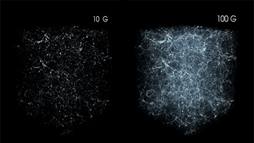Carrying ‘Elephants’ and ‘Mice’ at the Speed of Light:
Trivia question: What's almost 13,000 miles long, less than an inch wide, and can carry elephants and mice at the speed of light? Also, when in the company of a friendly giant, it can do up to twenty thousand trillion calculations each second.
 Image courtesy of Lawrence Berkeley National Laboratory
Image courtesy of Lawrence Berkeley National Laboratory
When the new 100-gigabit-per-second Energy Sciences Network (ESnet) goes live, it will be the world's fastest continent-spanning science network.
No, it's not that.
It's not that either, but it was a good guess.
Rather, it's the Department of Energy's (DOE's) 100 Gbps national science network (built by the Energy Sciences Network) which just came online. The network currently connects all DOE Office of Science laboratories and facilities through about 13,000 miles of fiber. Three of these sites – Argonne, Berkeley and Oak Ridge – already have 100 Gbps local connections to this network and other DOE labs will also upgrade their local connections soon as they install routers capable of operating at that speed. (A prototype of the network was deployed last year, and its success opened the way to this more permanent network.)
The three labs that have already upgraded their local connections are home to the some of the world's most powerful supercomputers. Titan, at Oak Ridge, was just named the world's fastest, with a theoretical peak performance of almost 27 petaflops, the ability to do some twenty-seven thousand trillion calculations each second. Mira, at Argonne Lab, is not far behind, with a peak performance of 10 petaflops. Hopper, at Berkeley Lab, also posts 1 petaflop performance. That makes it the world's fastest network connected to the world's fastest supercomputers.
So how fast is 100 Gbps? The fastest commercial Internet providers typically offer service capable of going about a tenth of that speed, 10 Gbps. However, the service is often divided among many users, so the transfer tends to be far slower. So in the one hour that it takes an average home Internet connection to download an HD movie, the new network could download 20 years of data from the Hubble Space Telescope.
 Image courtesy of Lawrence Berkeley National Laboratory
Image courtesy of Lawrence Berkeley National Laboratory
The left image shows a computer visualization of the universe using ESnet's 10 Gigabit per second (Gbps) network. The right image shows the same visualization using the 100 Gbps newtork.
So yes, the network can carry elephants and mice. ‘Elephants' are massive scientific datasets that travel online, while ‘mice' are much smaller files – regular email messages, images and videos. And that's why scientists need the speed.
The Office of Sciences' world-class facilities; its supercomputers as well as its particle accelerators, its genome sequencing facilities and its extremely bright light sources, generate an enormous amount of information. (In fact, the new, high speed network is itself considered to be a unique user facility that facilitates scientific discovery.) Sharing that information in the search for new insights requires copious bandwidth, and scientists are pushing the limits of the current network. And as the poet (James Russell Lowell) observed, "They must upward still, and onward, who would keep abreast of Truth."
That's really what the Energy Sciences Network and the Office of Science are all about: Making connections, speeding insights, and yes, occasionally carrying both elephants and mice.
The Department's Office of Science is the single largest supporter of basic research in the physical sciences in the United States and is working to address some of the most pressing challenges of our time. For more information please visit http://science.energy.gov/about. For more information about the Energy Sciences Network, please go to http://www.es.net/.
Charles Rousseaux is a Senior Writer in the Office of Science.

